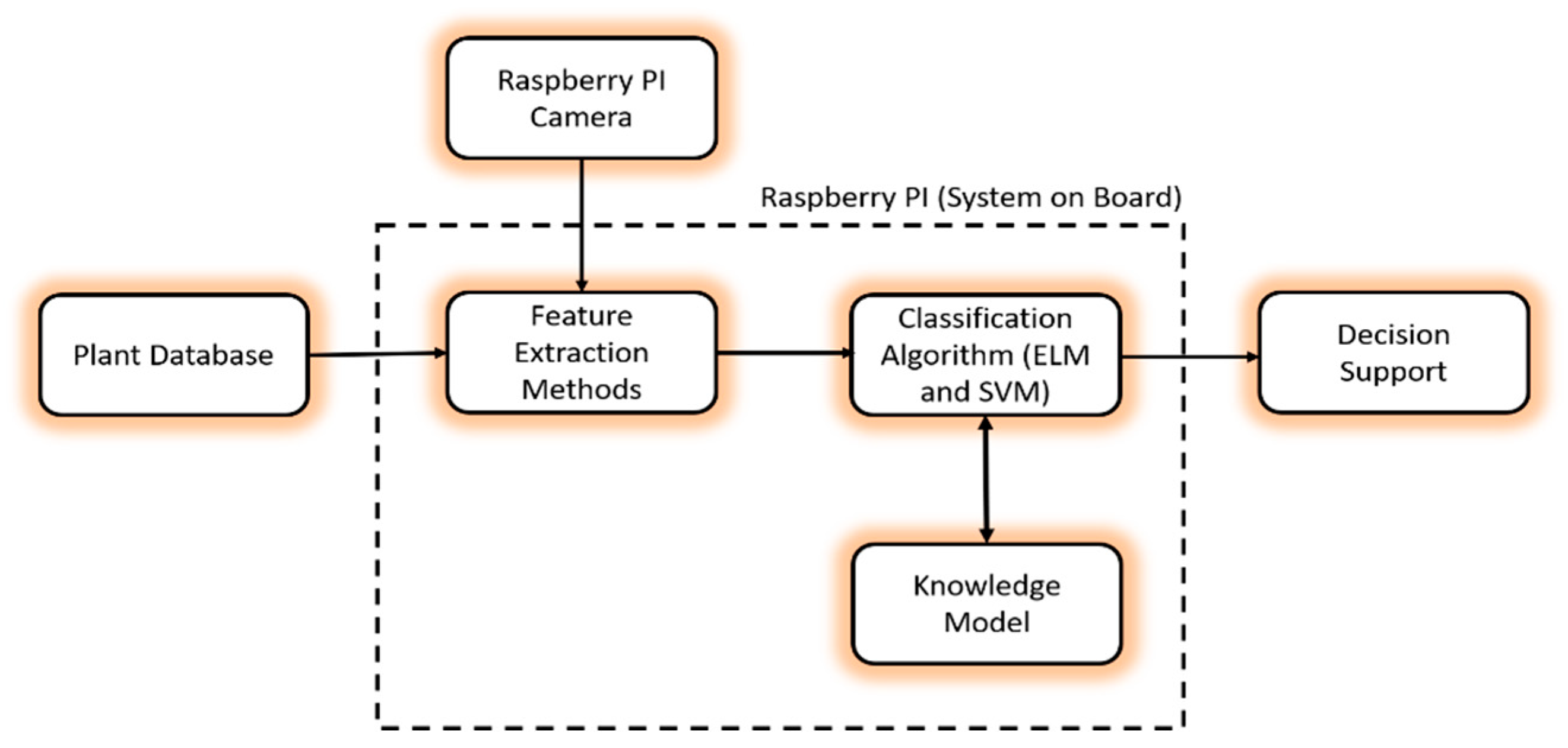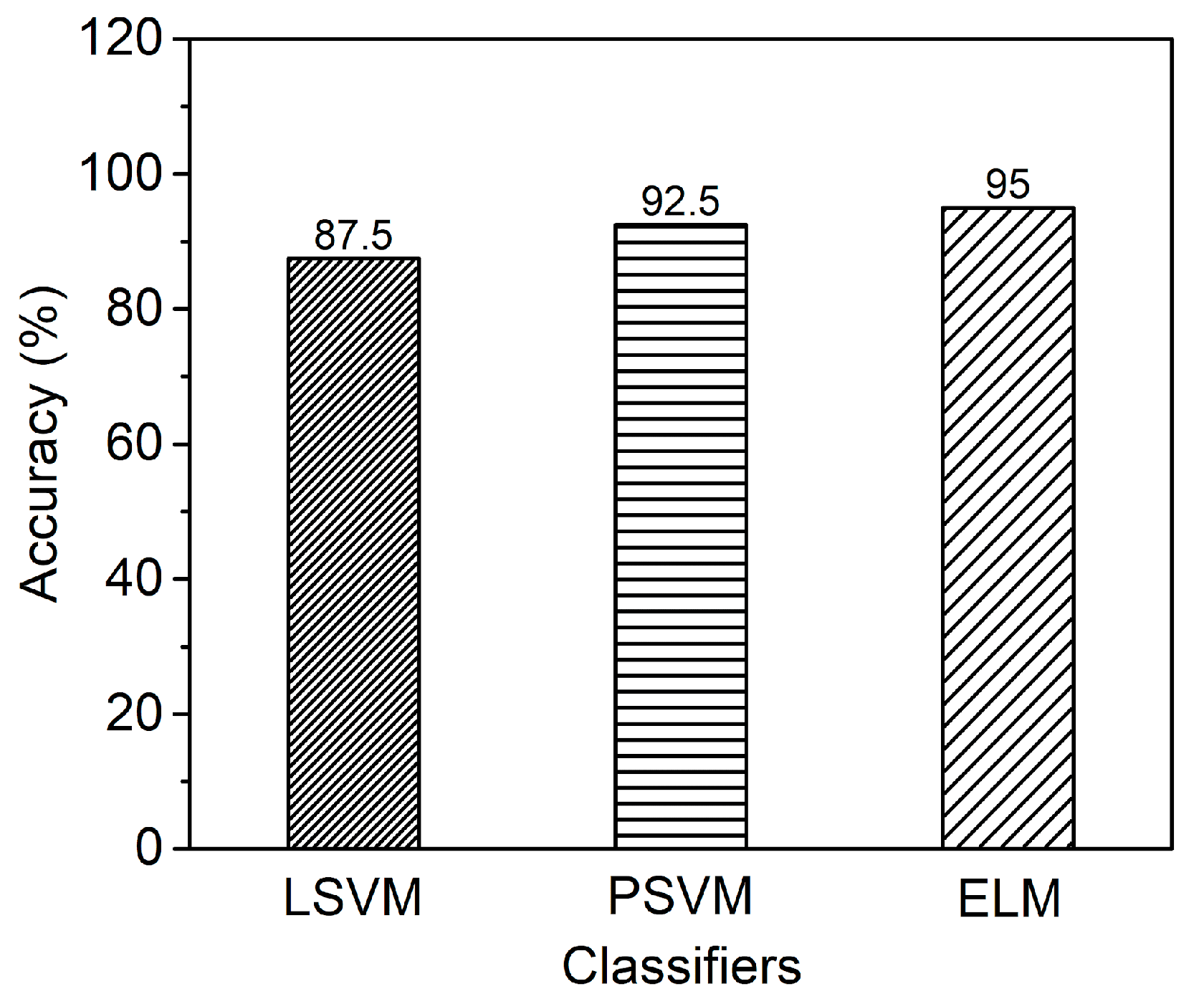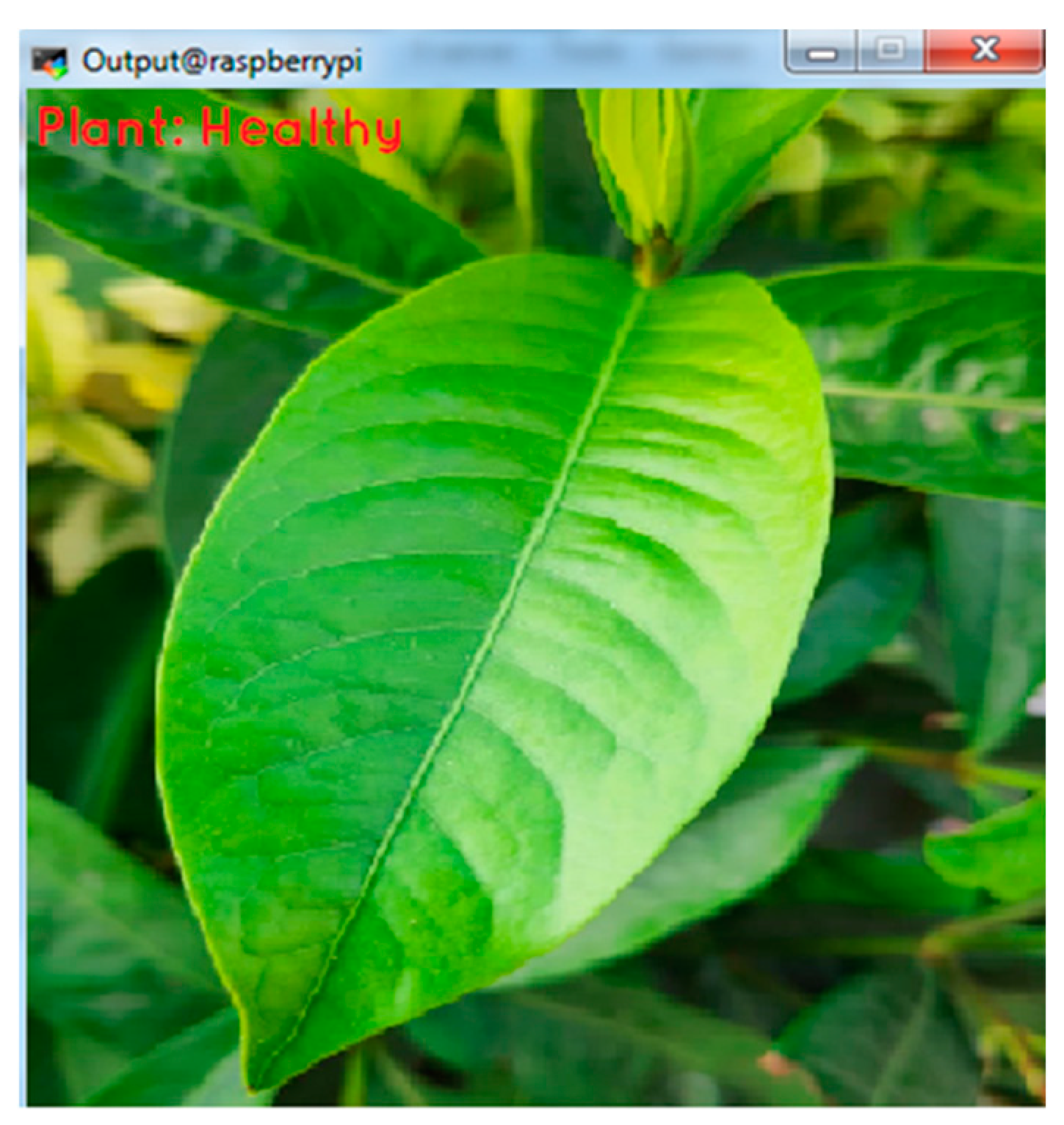Intelligent Plant Disease Identification System Using Machine Learning †
Abstract
:1. Introduction
2. Materials and Methods
2.1. Proposed System
2.2. Extraction of Informative Features
2.3. Machine Learning Algorithms
3. Results and Discussion
4. Conclusions
Author Contributions
Conflicts of Interest
References
- Zhou, C.; Zhang, Z.; Yang, Y.; Gao, Q. Comparative analysis of photosynthesis of three Stipa species based on a photosynthesis model. In Proceedings of the 2011 IEEE Chinese Control and Decision Conference (CCDC), Mianyang, China, 23–25 May 2011; pp. 421–425. [Google Scholar]
- Pipitsunthonsan, P.; Sopharat, J.; Sirisuk, P.; Chongcheawchamnan, M. Leaf Sensor for Stomata Transpiration Monitoring Using Temperature and Humidity. In Proceedings of the 2018 IEEE 21st International Symposium on Wireless Personal Multimedia Communications (WPMC), Chiang Rai, Thailand, 25–28 November 2018; pp. 252–255. [Google Scholar]
- Singh, U.P.; Chouhan, S.S.; Jain, S.; Jain, S. Multilayer convolution neural network for the classification of mango leaves infected by anthracnose disease. IEEE Access 2019, 7, 43721–43729. [Google Scholar] [CrossRef]
- Raghavendra, B.K. Diseases Detection of Various Plant Leaf Using Image Processing Techniques: A Review. In Proceedings of the 2019 IEEE 5th International Conference on Advanced Computing & Communication Systems (ICACCS), Coimbatore, India, 15–16 March 2019; pp. 313–316. [Google Scholar]
- Francis, J.; Anoop, B.K. Identification of leaf diseases in pepper plants using soft computing techniques. In Proceedings of the 2016 IEEE Conference on Emerging Devices and Smart Systems (ICEDSS), Namakkal, India, 4–5 March 2016; pp. 168–173. [Google Scholar]
- Sabrol, H.; Satish, K. Tomato plant disease classification in digital images using classification tree. In Proceedings of the 2016 IEEE International Conference on Communication and Signal Processing (ICCSP), Melmaruvathur, India, 6–8 April 2016; pp. 1242–1246. [Google Scholar]
- Militante, S.V.; Gerardo, B.D.; Dionisio, N.V. Plant Leaf Detection and Disease Recognition using Deep Learning. In Proceedings of the 2019 IEEE Eurasia Conference on IOT, Communication and Engineering (ECICE), Yunlin, Taiwan, 3–6 October 2019; pp. 579–582. [Google Scholar]
- Dhakate, M.; Ingole, A.B. Diagnosis of pomegranate plant diseases using neural network. In Proceedings of the 2015 IEEE Fifth National Conference on Computer Vision, Pattern Recognition, Image Processing and Graphics (NCVPRIPG), Patna, India, 16–19 December 2015; pp. 1–4. [Google Scholar]
- Jaisakthi, S.M.; Mirunalini, P.; Thenmozhi, D. Grape Leaf Disease Identification using Machine Learning Techniques. In Proceedings of the 2019 IEEE International Conference on Computational Intelligence in Data Science (ICCIDS), Chennai, India, 21–23 February 2019; pp. 1–6. [Google Scholar]
- Maniyath, S.R.; Vinod, P.V.; Niveditha, M.; Pooja, R.; Shashank, N.; Hebbar, R. Plant disease detection using machine learning. In Proceedings of the 2018 IEEEInternational Conference on Design Innovations for 3Cs Compute Communicate Control (ICDI3C), Bangalore, India, 25–28 April 2018; pp. 41–45. [Google Scholar]
- Das, A.; Bucksch, A.; Price, C.A.; Weitz, J.S. ClearedLeavesDB: An online database of cleared plant leaf images. Plant Methods 2014, 10, 8. [Google Scholar] [CrossRef] [PubMed]
- Hu, N.M.-K. Visual pattern recognition by moment invariants. IEEE Trans. Inf. Theory 1962, 8, 179–187. [Google Scholar]
- Haralick, R.M.; Shanmugam, K.; Dinstein, I. Textural Features for Image Classification. IEEE Trans. Syst. Man Cybern. 1973, 6, 610–621. [Google Scholar] [CrossRef]
- Alagumariappan, P.; Krishnamurthy, K. A Thermal Sensor-Based Decision Support System for the Identification of Roof Leaks and Cracks. Proceedings 2020, 42, 7. [Google Scholar]
- Onay, A.; Onay, M.; Abul, O. Classification of nervous system withdrawn & approved drugs with ToxPrint features via machine learning strategies. Comput. Methods Prog. Biomed. 2017, 142, 9–19. [Google Scholar]
- Bucurica, M.; Dogaru, R.; Dogaru, I. A comparison of extreme learning machine and support vector machine classifiers. In Proceedings of the 2015 IEEE International Conference on Intelligent Computer Communication and Processing (ICCP), Cluj-Napoca, Romania, 3–5 September 2015; pp. 471–474. [Google Scholar]
- Ding, S.; Zhao, H.; Zhang, Y.; Xu, X.; Nie, R. Extreme learning machine: Algorithm, theory and applications. Artif. Intell. Rev. 2015, 44, 103–115. [Google Scholar] [CrossRef]
- Shi, J.; Cai, Y.; Zhu, J.; Zhong, J.; Wang, F. SEMG-based hand motion recognition using cumulative residual entropy and extreme learning machine. Med Biol. Eng. Comput. 2013, 51, 417–427. [Google Scholar] [CrossRef] [PubMed]





Publisher’s Note: MDPI stays neutral with regard to jurisdictional claims in published maps and institutional affiliations. |
© 2020 by the authors. Licensee MDPI, Basel, Switzerland. This article is an open access article distributed under the terms and conditions of the Creative Commons Attribution (CC BY) license (https://creativecommons.org/licenses/by/4.0/).
Share and Cite
Alagumariappan, P.; Dewan, N.J.; Muthukrishnan, G.N.; Raju, B.K.B.; Bilal, R.A.A.; Sankaran, V. Intelligent Plant Disease Identification System Using Machine Learning. Eng. Proc. 2020, 2, 49. https://doi.org/10.3390/ecsa-7-08160
Alagumariappan P, Dewan NJ, Muthukrishnan GN, Raju BKB, Bilal RAA, Sankaran V. Intelligent Plant Disease Identification System Using Machine Learning. Engineering Proceedings. 2020; 2(1):49. https://doi.org/10.3390/ecsa-7-08160
Chicago/Turabian StyleAlagumariappan, Paramasivam, Najumnissa Jamal Dewan, Gughan Narasimhan Muthukrishnan, Bhaskar K. Bojji Raju, Ramzan Ali Arshad Bilal, and Vijayalakshmi Sankaran. 2020. "Intelligent Plant Disease Identification System Using Machine Learning" Engineering Proceedings 2, no. 1: 49. https://doi.org/10.3390/ecsa-7-08160
APA StyleAlagumariappan, P., Dewan, N. J., Muthukrishnan, G. N., Raju, B. K. B., Bilal, R. A. A., & Sankaran, V. (2020). Intelligent Plant Disease Identification System Using Machine Learning. Engineering Proceedings, 2(1), 49. https://doi.org/10.3390/ecsa-7-08160



